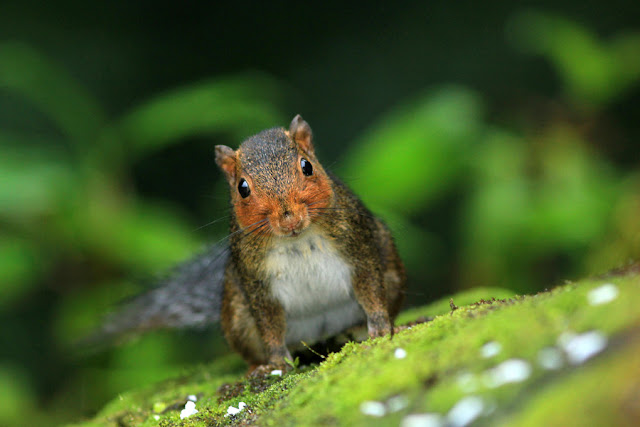I got a chance to visit Doi Lang again on August 18, after my last visit in April. I didn't expect to see anything much, since it was still in the middle of rainy season. However, it turned out that birds were actually pretty good. We constantly came across bird waves throughout the day despite the showering rain. Lots of Velvet-fronted Nuthatches, Yellow-bellied Warbler, some Speckled and White-browed Piculets, a female Asian Paradise-Flycatcher, 2 Dark-sided Flycatchers, 2 female Asian Emerald Cuckoos, White-browed Shrike-Babblers and Scarlet Minivets are just some examples. But the real highlights were at the feeding area at the army base camp.
 |
| Adult Scarlet-faced Liocichla |
 |
| Slightly duller juvenile with brown iris |
 |
| Adult Silver-eared Laughingthrush |
 |
| Dark-backed Sibia |
The soldiers at the camp always put out some food, normally rice and various kinds of fruits, for the birds making them really obliging and fun to photograph. Even though the rain was pouring most of the time, birds were pretty active at the feeding station. The main visitors were a family group of Silver-eared Laughingthrushes and several aggressive Dark-backed Sibias. A pair of Spectacled Barwings made an appearance once, as well as a male White-tailed Robin and a female Large Niltava. However, my most favourite was a family group of Scarlet-faced Liocichlas.
 |
| One of the pair of Spectacled Barwings |
 |
| A lucky shot; without flash and still looking sharp |
 |
| Here's another shot with flash |
 |
| Another shot of the juvenile |
There were 3 individuals of the Scarlet-faced Liocichla, 2 adults and 1 juvenile. One of the adult has moulting tail feathers, while the other has already finished its moult. The juvenile bird was a bit duller, especially on the cheeks, with dark brown iris. Doi Lang is sure the easiest place on earth to see this amazingly coloured species in the wild. They are extremely shy elsewhere. Here you can just sit on your chair and watch them flying up and down the feeding area and regularly perching closely together to preen each other.
 |
| Asian Red-cheeked Squirrel |
 |
| A curious look |
 |
| Some more shots of the Silver-eared Laughingthrushes |
 |
| The juvenile is duller, especially on the cheek and throat |
 |
| Female Large Niltava |
To my surprise, 2 strictly insectivorous species showed up at the feeding area; a male White-tailed Robin and a female Large Niltava. The robin only showed up briefly and disappeared into the forest as soon as I turned my camera towards it. The niltava, however, came perching right at the feeding pad and picked up a grain of rice. Probably it didn't quite like it so the flew off shortly. Apart from the birds, there were 2 Asian Red-cheeked Squirrels constantly visiting the feeding area as well. Both of them didn't seem so fond of each other though, as they constantly chased each other off if they happened to show up at the feeding area at the same time.
 |
| Male (left) and female (right) Mountain Bamboo Partridge |
 |
| Eclipse male Red Junglefowl |
Birds along the road were generally good too. I counted 6 Red Junglefowls along the way uphill. It was something quite special to see this species in such number as illegal hunting for food is still going on. All of the males that were found were in their eclipse plumage, lacking bright fiery red and orange feathers hanging from the neck and long glossy tail feathers. However, they still looked gorgeous. A pair of Mountain Bamboo Partridge was found on the way up to the mountain too. Unfortunately they were both too elusive and always ran away just too fast for the camera to capture a decent shot. Seems like I need to make a revisit!
























Such a wonderful learning experience for me. I've never heard of these birds and to find out about them with such beautiful photography is awesome. I don't know which are my favourites but I think many of them including the squirrel have such cool rusty, rich colours.
ReplyDeleteScarlet Faced what? I have no idea how to pronounce that............
ReplyDeleteGreat pictures of it though.
Imagine how I struggled to pronounce that name for the first time, Stu. I have no idea how it got this weird name. Sounds Mexican to me....
DeleteGorgeous shot Ayuwat, I've seen some somewhere ;-) The diversity around you is stunning and you capture it very well!
ReplyDeleteFantastic shots as usual. Looks like you had a great trip.
ReplyDeleteThe Loichicla is just so colourful. Good outing and a great writeup Ayuwat.
ReplyDeleteLovely shots - especially the liochichla...... I've always found them very skulky (if that's a word), it's an achievement to get a whole one in the frame !
ReplyDeleteThose Scarlet-faced Loichicla is quite unusual looking - never heard of it I'm afraid but it looks like a member of the babbler family perhaps? By the way the Sparrowhawk was found right next to car. It probably hit the car window while chasing a samll bird.
ReplyDelete